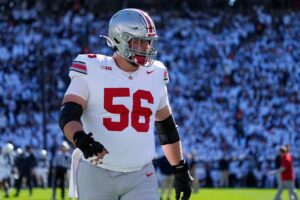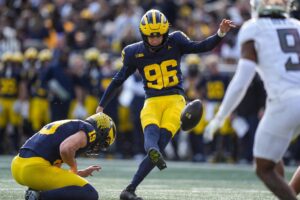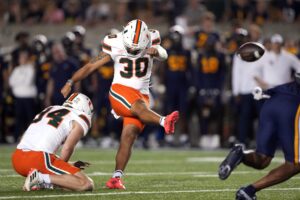The idea of college football in the Spring is gaining some momentum. The surge in impetus lacks justifiable argument, but it is there none the less. Hey, when someone with the gravitas of Oklahoma’s Lincoln Riley says the idea needs to be on the table, it is going to be put there. Conversely, when we talked with Arizona’s Kevin Sumlin several weeks ago, he also said the idea needed to be on the table…..just way at the very end of the table. Essentially, if this is the family Thanksgiving table, this belongs closer to the kids table, near the green bean casserole.
Most who follow the sport acknowledge there must be a Fall sports season, including college football. Not because we are concerned about your tailgate parties, if you even pay the money to go to the games. The vast majority of college football fans are sitting at home watching the games. Their money is doing none of the talking in this debate.
College Football In The Spring? Seriously?
We have to start with the premise that college sports needs more of a conversation. There is a financial calamity lurking if all college sports are erased for the year. This is not a topic where we can justifiably shrug our shoulders as if that is just the way it goes. This is not pro sports with billionaire owners collecting on their catastrophe insurance if there is no season. These are educational institutions that, wrongly so, have banked much of their public profile on what happens with their athletic departments. Post-season success and championship rings equals increases in applications for incoming freshmen, bigger donations from boosters, and more money allocated to capital works projects on the campuses.
Now, as the country faces a scientifically proven pandemic, the likes of which have not been seen in 100 years, schools are staring a financial abyss square in the eyes.
The Financial Crevasse
Few schools will fully open in the Fall. Most are doing some hybrid of on-line and in-person instruction. That means a huge monetary loss in housing fees, dining hall revenue, and proceeds from other on-campus activities. With a lot of belt-tightening going on across the country, donations to the school, or the athletic department specifically, are going to be scarce. Now cancel the Fall sports. Ticket revenue tanks, even for those who were going to have limited fan participation. And then the nuclear bomb drops….the loss of TV contracts and the shared revenue that comes from bowl games and the playoffs.

There are more than a few schools who will never be able to recover from that. Every school in the country already got a one-time bailout in May from the federal COVID emergency fund. There won’t be another any time soon. Sure, the University of Alabama will survive, but will Memphis? UCF? Iowa St? Minnesota? There will be some of the P5 schools and certainly more of the Group of Five schools that will struggle to withstand the financial pitfalls. Non-revenue sports will be the first to go, which means thousands of student-athletes will lose their access to go to college. Certainly the fallout will not be contained to sports. Academic programs will be cut since so many are inappropriately at the whim of the athletic department revenue streams. There will be a quake throughout the college systems that will be felt across the country and for years to come.
That gets us back to the idea of moving the season to the Spring. Its intent is to ensure that there even is a football season, or something with all of the sports that would have been in the Fall.
The Unanswered Spring Checklist
While a handful of people are jumping on the bandwagon each week, few, if any are acknowledging the flaws in its excessive simplicity. The questions that come with the move are being addressed by virtually no one. The Dallas Morning News ran a piece Sunday advocating for such a move. They said the only “minus” was, “Football recruits who planned to enroll in college next spring would miss their senior seasons.” Really?
Certainly, the list of obstacles for a Spring season is much, much longer than that.
- We must proceed with any plan on the assumption that this is a one-year aberration. We will have the answers to go forward as planned next season. To play this season in the Spring means you are going to be asking the players who are back for the 2021 Fall season to play 24 games in a 12-month calendar. If we are going to bail out on Fall 2020 for the safety of the players, then let’s be real. The NFL players don’t even play 24 games in a 12-month calendar and they are well paid. You would be ending the revised college season sometime in May. You have to cancel the off-season “voluntary” workout to let them rest for a month, and then have them back in camp by mid to late July for a regularly scheduled 2021 season. It is physically absurd to ask that of college players.
- What do you do with the early graduates? You know…the ones who did everything we ask of them in that they played sports and actually finished academically ahead of time, in December? Are you going to have them take some nonsense ballroom dancing class to keep them eligible through the new Spring season. That keeps them on scholarship on the school’s dime? And all in the name of letting them play in the Spring.
- What about the early enrollees? Do you really think kids who are two months out of high school are going to be ready to play full-speed college football without the Spring training camp they usually get? Or will we keep them out completely? Some states are unsure if there is going to be a Fall high school football season. That means academically, they may be ready to enroll in college in January, but may not have played football since their junior year of high school.
- Take the top five players of your favorite school’s roster and assume they will not play. Now this is no reason not to move the season, but Ohio State fans better be prepared to say goodbye to Justin Fields now. Clemson fans, you will have seen the last of Trevor Lawrence if the season moves to the Spring. The best of the draft eligible players, and those who think they are better than they are, are not going to risk injury against a 1-4 Rutgers team or an 0-5 Wake Forest team. Not when the games coincide with the NFL combine, pro days, and the NFL draft. Again, we are just preparing you for the inevitable with this one.
- Moving the entire post-season takes more than just some keyboard strokes on a computer. We may laugh at the “Zippity-Do-Dah Bowl” every year, with its 17,000 people in attendance. And rightfully so. But the cities that host those games count on the 17,000 visitors for hotels, restaurants, and retail sales. And TV contracts are tied to them. There are 41 bowl games, not including the playoffs. Go ahead. Tell me your plans and schedules to move every single one of them to May-June.
Unlike Any Other Time
The games should never take precedent over the health of the student-athletes, the coaches, and the staffs. And there is too much ridiculous talk about how these are young players who can overcome the virus. That last point, so often pointed out by fans who are too myopic about having their games back, ignores the fact that Nick Saban and Mack Brown are 68 years old, and vulnerable to the virus. Les Miles is 67. Herm Edwards is 66. David Cutcliffe is 65. It is a long list of head coaches and assistants in the same AARP age bracket, and they go home to families.

This is a multi-layer problem. Most conferences have made their plans for shortened seasons. That is closer to reality and puts them closer to playing. Let the season be pushed back by a month into late September. You will be closer to full participation by more schools. Most are playing all conference schedules or all conference +1. There is a way to get in some of the games against lesser opponents…the ones that are desperate for the money.
There are clear and specific ways to get it all in. If you are in the camp of moving to Spring, there needs to be a way that no one has shown. We don’t want schools soaping up the windows and locking the doors due to financial hardships. But you’ve got to do better than to think you can hit a few keystrokes on a computer and just move the calendar. You owe us a plan. The devil is always in the details.






